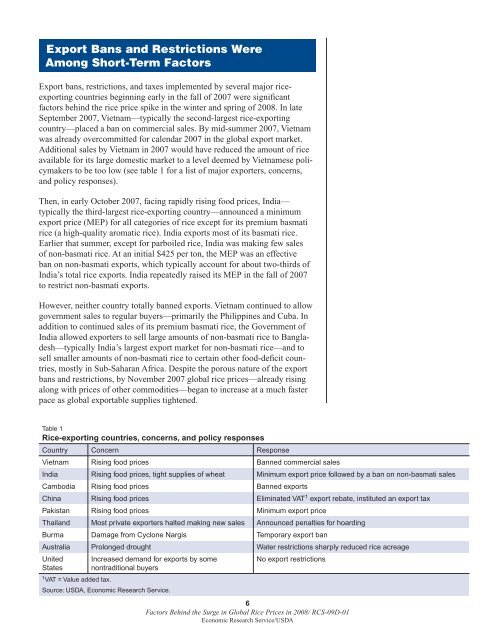Childs et al. - 2009 - Factors behind the rise in global rice prices in 2
Childs et al. - 2009 - Factors behind the rise in global rice prices in 2
Childs et al. - 2009 - Factors behind the rise in global rice prices in 2
Create successful ePaper yourself
Turn your PDF publications into a flip-book with our unique Google optimized e-Paper software.
Export Bans and Restrictions Were<br />
Among Short-Term <strong>Factors</strong><br />
Export bans, restrictions, and taxes implemented by sever<strong>al</strong> major <strong>rice</strong>export<strong>in</strong>g<br />
countries beg<strong>in</strong>n<strong>in</strong>g early <strong>in</strong> <strong>the</strong> f<strong>al</strong>l of 2007 were significant<br />
factors <strong>beh<strong>in</strong>d</strong> <strong>the</strong> <strong>rice</strong> p<strong>rice</strong> spike <strong>in</strong> <strong>the</strong> w<strong>in</strong>ter and spr<strong>in</strong>g of 2008. In late<br />
September 2007, Vi<strong>et</strong>nam—typic<strong>al</strong>ly <strong>the</strong> second-largest <strong>rice</strong>-export<strong>in</strong>g<br />
country—placed a ban on commerci<strong>al</strong> s<strong>al</strong>es. By mid-summer 2007, Vi<strong>et</strong>nam<br />
was <strong>al</strong>ready overcommitted for c<strong>al</strong>endar 2007 <strong>in</strong> <strong>the</strong> glob<strong>al</strong> export mark<strong>et</strong>.<br />
Addition<strong>al</strong> s<strong>al</strong>es by Vi<strong>et</strong>nam <strong>in</strong> 2007 would have reduced <strong>the</strong> amount of <strong>rice</strong><br />
available for its large domestic mark<strong>et</strong> to a level deemed by Vi<strong>et</strong>namese policymakers<br />
to be too low (see table 1 for a list of major exporters, concerns,<br />
and policy responses).<br />
Then, <strong>in</strong> early October 2007, fac<strong>in</strong>g rapidly ris<strong>in</strong>g food p<strong>rice</strong>s, India—<br />
typic<strong>al</strong>ly <strong>the</strong> third-largest <strong>rice</strong>-export<strong>in</strong>g country—announced a m<strong>in</strong>imum<br />
export p<strong>rice</strong> (MEP) for <strong>al</strong>l categories of <strong>rice</strong> except for its premium basmati<br />
<strong>rice</strong> (a high-qu<strong>al</strong>ity aromatic <strong>rice</strong>). India exports most of its basmati <strong>rice</strong>.<br />
Earlier that summer, except for parboiled <strong>rice</strong>, India was mak<strong>in</strong>g few s<strong>al</strong>es<br />
of non-basmati <strong>rice</strong>. At an <strong>in</strong>iti<strong>al</strong> $425 per ton, <strong>the</strong> MEP was an effective<br />
ban on non-basmati exports, which typic<strong>al</strong>ly account for about two-thirds of<br />
India’s tot<strong>al</strong> <strong>rice</strong> exports. India repeatedly raised its MEP <strong>in</strong> <strong>the</strong> f<strong>al</strong>l of 2007<br />
to restrict non-basmati exports.<br />
However, nei<strong>the</strong>r country tot<strong>al</strong>ly banned exports. Vi<strong>et</strong>nam cont<strong>in</strong>ued to <strong>al</strong>low<br />
government s<strong>al</strong>es to regular buyers—primarily <strong>the</strong> Philipp<strong>in</strong>es and Cuba. In<br />
addition to cont<strong>in</strong>ued s<strong>al</strong>es of its premium basmati <strong>rice</strong>, <strong>the</strong> Government of<br />
India <strong>al</strong>lowed exporters to sell large amounts of non-basmati <strong>rice</strong> to Bangladesh—typic<strong>al</strong>ly<br />
India’s largest export mark<strong>et</strong> for non-basmati <strong>rice</strong>—and to<br />
sell sm<strong>al</strong>ler amounts of non-basmati <strong>rice</strong> to certa<strong>in</strong> o<strong>the</strong>r food-deficit countries,<br />
mostly <strong>in</strong> Sub-Saharan Africa. Despite <strong>the</strong> porous nature of <strong>the</strong> export<br />
bans and restrictions, by November 2007 glob<strong>al</strong> <strong>rice</strong> p<strong>rice</strong>s—<strong>al</strong>ready ris<strong>in</strong>g<br />
<strong>al</strong>ong with p<strong>rice</strong>s of o<strong>the</strong>r commodities—began to <strong>in</strong>crease at a much faster<br />
pace as glob<strong>al</strong> exportable supplies tightened.<br />
Table 1<br />
Rice-export<strong>in</strong>g countries, concerns, and policy responses<br />
Country Concern Response<br />
Vi<strong>et</strong>nam Ris<strong>in</strong>g food p<strong>rice</strong>s Banned commerci<strong>al</strong> s<strong>al</strong>es<br />
India Ris<strong>in</strong>g food p<strong>rice</strong>s, tight supplies of wheat M<strong>in</strong>imum export p<strong>rice</strong> followed by a ban on non-basmati s<strong>al</strong>es<br />
Cambodia Ris<strong>in</strong>g food p<strong>rice</strong>s Banned exports<br />
Ch<strong>in</strong>a Ris<strong>in</strong>g food p<strong>rice</strong>s Elim<strong>in</strong>ated VAT 1 export rebate, <strong>in</strong>stituted an export tax<br />
Pakistan Ris<strong>in</strong>g food p<strong>rice</strong>s M<strong>in</strong>imum export p<strong>rice</strong><br />
Thailand Most private exporters h<strong>al</strong>ted mak<strong>in</strong>g new s<strong>al</strong>es Announced pen<strong>al</strong>ties for hoard<strong>in</strong>g<br />
Burma Damage from Cyclone Nargis Temporary export ban<br />
Austr<strong>al</strong>ia Prolonged drought Water restrictions sharply reduced <strong>rice</strong> acreage<br />
United<br />
States<br />
Increased demand for exports by some<br />
nontradition<strong>al</strong> buyers<br />
1 VAT = V<strong>al</strong>ue added tax.<br />
Source: USDA, Economic Research Service.<br />
No export restrictions<br />
6<br />
<strong>Factors</strong> Beh<strong>in</strong>d <strong>the</strong> Surge <strong>in</strong> Glob<strong>al</strong> Rice P<strong>rice</strong>s <strong>in</strong> 2008/ RCS-09D-01<br />
Economic Research Service/USDA

















